
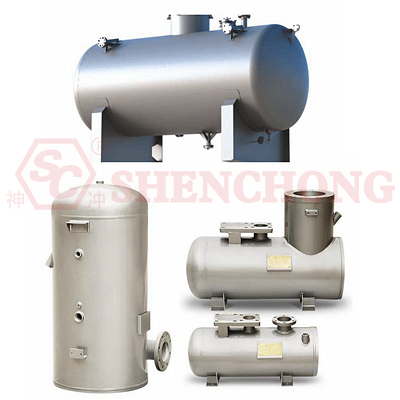
Pressure vessels refer to enclosed equipment that holds gas or liquid and carries a certain pressure. A pressure vessel is a closed container that can withstand pressure.
Pressure vessels have a wide range of applications, playing an important role in many sectors such as industry, civilian, military, and scientific research.
Among them, pressure vessels are most commonly used in the chemical and petrochemical industries, accounting for about 50% of the total number of pressure vessels used in the petrochemical industry alone. Pressure vessels are mainly used in the fields of chemical and petrochemical industries for heat transfer, mass transfer, reaction and other process processes, as well as for storing and transporting pressurized gases or liquefied gases.
It is also widely used in other industrial and civil fields, such as air compressors. All types of specialized compressors and auxiliary equipment for refrigeration compressors (coolers, buffers, oil-water separators, gas storage tanks, evaporators, liquid coolant storage tanks, etc.) belong to pressure vessels.
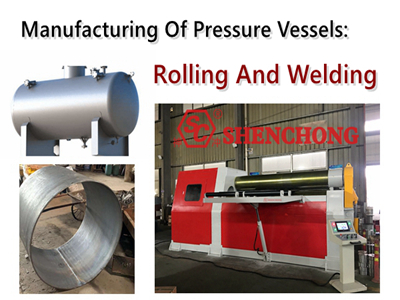
The manufacturing process of pressure vessels can generally be divided into:
Raw material acceptance process, marking process, metal plate cutting, rust removal, machining (including edge planning) process, sheet metal rolling, assembly process, welding (product welding test plate), non-destructive testing, hole marking, general inspection, heat treatment, pressure test process, and anti-corrosion process.
The manufacturing process of a single-layer cylinder mainly consists of material inspection, marking, cutting, rolling of the cylinder section, longitudinal weld welding, straightening, assembly of the cylinder section, circumferential weld welding, inspection, and other processes.
The rolling process of the cylinder section mainly consists of four steps: top bending, pre-rolling preparation, alignment, and rolling. We need to use a plate rolling machine for this processing step.
Common sheet metal rolling machines include three-roll rolling machines and four-roll rolling machines. Users can choose based on your sheet information, coil diameter, and process requirements.
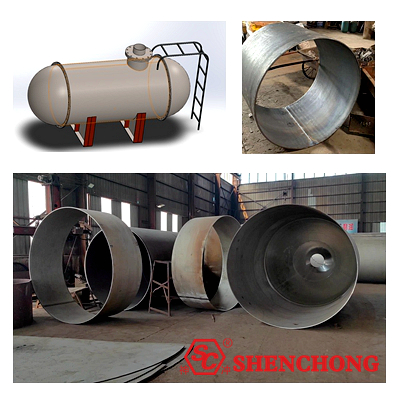
Pre bending, also known as indenter. When the sheet metal is rolled on a rolling machine, it is possible to produce straight edges. Therefore, before rolling, the sheet metal should be first treated to eliminate straight edges, that is, pre bending.
There are three main methods to eliminate straight edges: reserved straight edges, rolled straight edges, and molded straight edges.
Before rolling, the axis of the roller should be aligned to ensure parallelism. Otherwise, the actual downward pressure on both sides will be unequal, resulting in unequal bending radii on both sides of the cylinder section, forming a taper.
Place the pre bent sheet metal on the rolling machine before rolling, ensuring that the longitudinal centerline of the sheet metal is strictly parallel to the axis of the roller. Otherwise, the end edge of the rolled cylinder section is not a circle in the plane, but a spiral, called a staggered joint.
There are three types of rolls: cold roll, hot roll, and warm roll.
In actual operation, the rolling radius is not controlled by calculating the amount of pressing or pushing up, but by using an inner sample made of thin iron plate to verify the actual radius value of the rolled part. Then determine the amount of pressing for the next step.
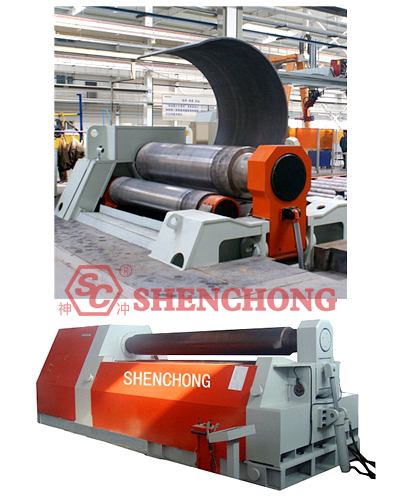
Generally, the total pressing amount needs to be completed in several stages, especially when the plate thickness is close to the maximum thickness of the rolling machine. During the rolling operation, attention should be paid to avoiding excessive rolling, as the rolling machine itself cannot be straightened back.
Different welding methods have different welding processes. The welding process is mainly determined based on the material, grade, chemical composition, structural type, and welding performance requirements of the welded parts.
Firstly, it is necessary to determine the welding method, such as manual arc welding, submerged arc welding, tungsten argon arc welding, gas shielded metal arc welding, etc. There are many types of welding methods that can only be selected based on specific circumstances.
After determining the welding method, formulate the welding process parameters. The types of welding process parameters vary. For example, manual arc welding mainly includes: electrode model (or brand), diameter, current, voltage, welding power source type, polarity connection method, welding layer number, number of passes, inspection method, and so on.
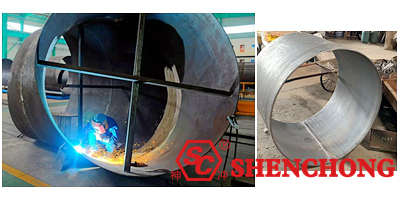
Before welding, grooves should be made and welding test plates should be prepared. Perform post weld heat treatment according to national standards and drawing requirements after welding. The test plate should be welded and heat treated simultaneously with the cylinder section.
When assembling cylinder sections, attention should be paid to ensuring the adaptability of the circumferential weld groove and the weld spacing.
Pressure vessels refer to devices that can store liquids or gases with predetermined pressure, including salt tanks, catalysts, and gas boilers. Pressure vessels can store liquids or gases with predetermined pressure, and can also serve as a storage tool. With the continuous development of industrialization, pressure vessels have undergone rapid development in recent years.
With the development of manufacturing and continuous improvement of technology, the pressure vessel manufacturing industry will continue to develop towards high-end manufacturing. The improvement of equipment manufacturing level, product specification design, and component materials will all promote the technological progress of the pressure vessel manufacturing industry. Users in the pressure vessel industry should purchase high-quality plate rolling machines and welding equipment to meet higher industry standards.
Intelligent manufacturing technology is widely used in traditional industry production lines, and intelligent information systems can improve production efficiency and energy conservation and environmental protection levels. In the future, pressure vessel manufacturing enterprises will also choose intelligent technology to improve product quality and production efficiency, and achieve standardized operation of the industry.